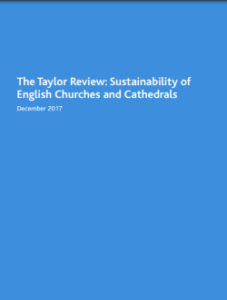 An independent review, chaired by Bernard Taylor, into the sustainability of Church of England Church and Cathedral buildings, has been published by the Department for Digital, Culture, Media & Sport, which calls for churches to be opened up for new and different uses by communities, to help build a more sustainable future for the buildings.
An independent review, chaired by Bernard Taylor, into the sustainability of Church of England Church and Cathedral buildings, has been published by the Department for Digital, Culture, Media & Sport, which calls for churches to be opened up for new and different uses by communities, to help build a more sustainable future for the buildings.
The Taylor Review writes:
…The buildings of the Church of England play a vital role in our national identity, in the provision of public services and in the sense of identity in communities, whether urban or rural, large or small, all over the country. The recommendations of this report are focused on targeting resources and funding to promote care, maintenance and community engagement, whilst supporting the thousands of people, primarily volunteers, who tirelessly commit their time and expertise to their local church building. The Panel believes these recommendations are critical to reinforcing and preserving the considerable investment made in these assets over the last forty years by the Government, HLF and grant-giving charities and by congregations around the country.
This approach to the use and maintenance of the buildings will help communities to see the value and potential of their church and give them the tools to build long term independence and sustainability for the future.
Recommendations
Enhancing and resourcing community use and care of church buildings
- A national network of Community Support Advisers (CSAs) should be put in place to build cross-community relationships and promote wider and more mixed use of church buildings.
- The Church of England should continue its work to simplify church buildings’ management through the Faculty System. This work should prioritise elements relating to adaptations to allow the building to remain in use both as a place of worship and a community resource and seek to harmonise the process across all dioceses.
- The law should be clarified, whether through legislative change or the issue of guidance, to establish that local authorities are not prohibited from awarding funding to churches.
Supporting the good care and timely maintenance of buildings
- A network of Fabric Support Officers (FSOs) should be implemented. This network will provide churches with access to skills and resources including maintenance assessment, building management and maintenance and the ability to guide PCCs as to how to prioritise and fund works.
- Repairs should be funded as much as possible locally, with the aim of this proportion increasing as, through the work of the CSAs, communities become more engaged. Any balance (to ensure timely execution of works) should come from a Minor Repairs Fund, to be administered on the advice of FSOs.
- FSOs should visit each listed church building within their area of responsibility regularly (expected to be annually) and develop a Minor Repairs Plan, to be updated regularly, and a rolling ten-year Major Repairs Plan. A review of these plans by church architects or surveyors every five years should be carried out as part of a Quinquennial Inspection.
- The PCC of each church, as the body corporate with responsibility for the building fabric, should nominate a named individual to act on its behalf in taking forward routine maintenance and repairs and to be the key point of contact for the Fabric Support Officer.
- Planned major repairs (long term maintenance) should be financed principally by local fundraising and topped up where proven necessary from a Major Repairs Fund.
- The Panel considers that a nationally administered fund for works to keep cathedrals safe and open, similar to the First World War Centenary Cathedral Repairs Fund, should be considered as a separate exercise.
- At least two pilot studies, covering both urban and rural contexts, should be conducted to test and develop the recommendations of this report.
Access and download the Report
For more background see the DBW article
